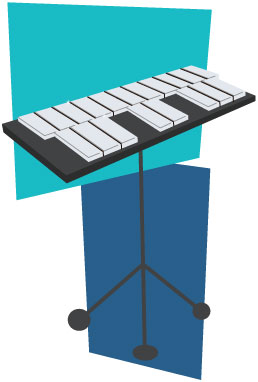Hey Kids, It's a Glockenspiel | History, Fun Facts, and More
from the Meet the Orchestra Index

Hey Kid's, It's a Glockenspiel
Learn glockenspiel history, how it's made, how it's played, and about the percussion family.
Glockenspiel is a German word which means "bell play." The glockenspiel is similar to the German carillon and the French celesta. However, the carillon and celesta are played using a keyboard while the glockenspiel is played with mallets. Unlike most percussion instruments, the glockenspiel produces a pitch when struck.
History
The glockenspiel began as a set of individual bells that were replaced by steel bars near the end of the 17th century. In the beginning, the glockenspiel was only considered a substitute for real bells. But gradually the glockenspiel became an instrument in its own right.
How It's Played
To make a sound on the glockenspiel the player must strike a bar with a mallet. When the player strikes a bar with a hard mallet, the glockenspiel produces a bright and sharp sound. When the player strikes a bar with a soft mallet a more muted sound is produced.
How It's Made
The glockenspiel is similar to the xylophone, though its bars are made of steel, and it plays notes that are much higher. The glockenspiel begins in a metal shop where the bars are cut and shaped in various lengths. Longer bars play low notes while the shorter bars play high notes. After the bars are carefully tuned, they are arranged from largest to smallest like a piano keyboard and then attached to its base.
The Percussion Family
The glockenspiel is a member of the percussion family. The percussion family includes the timpani, snare drum, bass drum, xylophone, glockenspiel, chimes, gong, cymbals, and many smaller percussion instruments.
Browse Related Free and Premium Sheet Music and More
Worksheets
Meet the Orchestra Scavenger Hunt | Percussion Family Worksheet